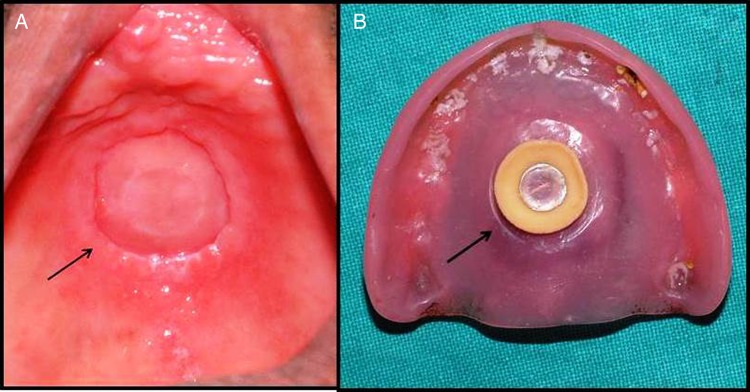Abstract
A poorly fitted prosthesis can give rise to a plethora of problems like pain, discomfort in mastication and speech and epulis fissuratum. Epulis fissuratum refers to reactive tissue response to excessive mechanical pressure imparted by the poor fit of prosthesis. In this article, we discuss a case of epulis fissuratum in a 69-year-old male patient.
Background
Epulis fissuratum, reactive fibrous hyperplasia or denture-induced fibrous hyperplasias are the various names attributed to reactive tissue response to chronic irritation and trauma caused by a badly fitted prosthesis. Persistent trauma to oral mucosa may predispose the patient to carcinoma. We present a case of faulty denture and the resultant epulis fissuratum in a 69-year-old male patient
Case presentation
A 69-year-old male patient reported to the outpatient department with a chief problem of discomfort while using his upper denture from the last 15–20 days. He has been wearing the current set of dentures from the last 4 years. His medical and family history was non-relevant. On examining the denture, a suction device (as shown by arrow in figure 1B) was acrylised on the tissue surface of the maxillary denture. On intraoral examination, a raw eroded irregular patch simulating the shape of the suction device was noticed in the middle of the hard palate (figure 1A). It was surrounded by erythema and was the cause of discomfort for the patient due to excessive and continuous mechanical pressure imparted by faulty maxillary denture. A diagnosis of denture-induced fibrous hyperplasia was made and the patient was instructed to stop wearing dentures.
Figure 1.

A 69-year-old man presenting with epulis fissuratum, (A) a raw, eroded, irregular patch resembling the shape of suction device seen on the middle of hard palate and (B) faulty maxillary denture with suction device (black arrow).
Differential diagnosis
The presence of epulis in patients without denture may be diagnostic of Crohn's disease.
Treatment
Withdrawal of the denture and topical application of analgesic gel over the affected site.
Outcome and follow-up
After complete healing of the lesion, the patient was referred to the prosthodontics department for fabrication of new dentures.
Discussion
The term ‘epulis’ was coined by Virchoff, and its dictionary meaning is ‘over the gums’. Over the years it was seen that the usage of this term is not appropriate as it refers only to site, and moreover the affected mucosa is usually the oral mucosa of the vestibular sulcus or of the palatal region and not the gingival mucosa. Thus, another term, ‘denture-induced fibrous hyperplasia’ is considered to be a much preferred term. Denture-induced fibrous hyperplasia is an adaptive growth caused by chronic irritation from badly adapted prosthesis with variable hypertrophy and hyperplasia.1
Trauma and irritation are the two main aetiological factors responsible for occurrence of epulis. Clinically, it presents as a raised sessile lesion in the form of folds with a smooth surface with normal or erythematous overlying mucosa. Because of chronic irritation, it may get traumatised and present with an ulcerated surface. It is considered as an overgrowth of intraoral tissues resulting from chronic irritation.2 This mucogingival hyperplasia is a reactive condition of oral mucosa to excessive mechanical pressure on mucosa (as seen in our patient).
It not only produces pain and discomfort but negatively affects the mastication, aesthetics and overall well-being of the patient. Chronic trauma to oral mucosa may predispose the patient to carcinoma.
Treatment includes immediate withdrawal of the ill-fitting prosthesis followed by topical application of antifungal agents and paste containing anaesthetics with local analgesics. Fabrication of new denture should be carried out. In cases of fibrous growth, excision of the lesion becomes necessary. Excision can be performed by either conventional surgical approaches or by using laser.3 In case of latter, postoperative pain and oedema are reported to be minimal.
Learning points.
Epulis fissuratum is the reactive tissue response to sustained mechanical pressure generated by ill-fitting prosthesis.
Chronic, sustained pressure can not only traumatise oral tissue but may also lead to malignancy
Topical application of antifungal agents and paste containing local analgesic and anesthetics is beneficial in treatment of epulis fissuratum
Footnotes
Competing interests: None.
Patient consent: Obtained.
Provenance and peer review: Not commissioned; externally peer reviewed.
References
- 1.Tamarit Borras M, Delgado Molina E, Berini Aytes L, et al. Removal of hyperplastic lesions of the oral cavity. A retrospective study of 128 cases. Med Oral Patol Oral Cir Bucal 2005;2013:151–62 [PubMed] [Google Scholar]
- 2.Regezi JA, Sciubba JJ, Jordan R. Oral pathology: clinical pathological correlations. 5th edn. Saunders, 2008 [Google Scholar]
- 3.Niccoli Fiho W, Neves AC, Fenna LP, et al. Removal of epulis fissuratum associated to vestibuloplasty with carbondioxide laser. Lasers Med Sci 1999;2013:203–6 [Google Scholar]


